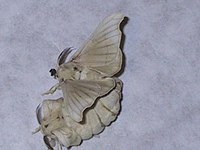
Photo from wikipedia
Bombyx mori nucleopolyhedrovirus (BmNPV) is one of primary silkworm pathogens and causes a serious damage of cocoon losses every year. Recent years, many works have been done to clarify the… Click to show full abstract
Bombyx mori nucleopolyhedrovirus (BmNPV) is one of primary silkworm pathogens and causes a serious damage of cocoon losses every year. Recent years, many works have been done to clarify the silkworm anti-BmNPV mechanism, and a significant progress has been made in screening and studying of genes and proteins related to BmNPV infection, but several of them lacked the proofs in vivo. In this study, to further validate the function of seven newly reported genes in vivo, including BmAtlatin-n, Bmferritin-heavy chain (BmFerHCH), Bmthymosin (BmTHY), Bmseroin1, Bmseroin2, Bmnuclear hormone receptors 96 (BmNHR96), and BmE3 ubiquitin-protein ligase SINA-like 10 (BmSINAL10), the response of them in the midgut, fat body, and hemolymph of differentially resistant strains (resistant strain YeA and susceptible strain YeB) at 48 h following BmNPV infection were analyzed. The results showed that the relative stable or upregulated expression level of BmAtlatin-n, BmTHY, Bmseroin1, and Bmseroin2 in YeA resistant strain following BmNPV infection further indicated their antiviral role in vivo, compared with susceptible YeB strain. Moreover, the significant downregulation of BmFerHCH, BmNHR96, and BmSINAL10 in both strains following BmNPV infection revealed their role in benefiting virus infection, as well as the upregulation of BmFerHCH in YeB midgut and BmSINAL10 in YeB hemolymph. These data could be used to complementary the proofs of the function of these genes in response to BmNPV infection.
Journal Title: Archives of insect biochemistry and physiology
Year Published: 2021
Link to full text (if available)
Share on Social Media: Sign Up to like & get
recommendations!